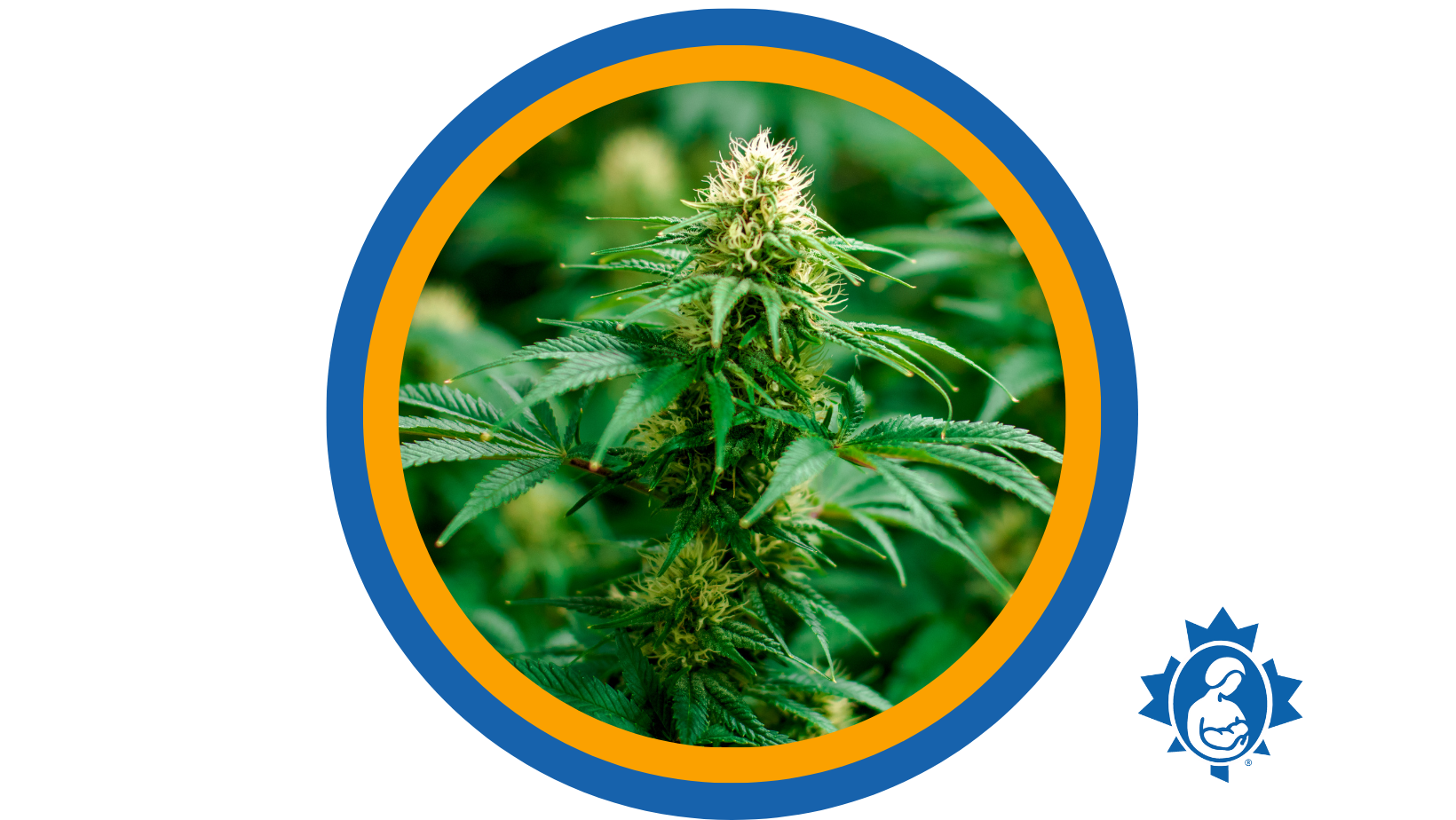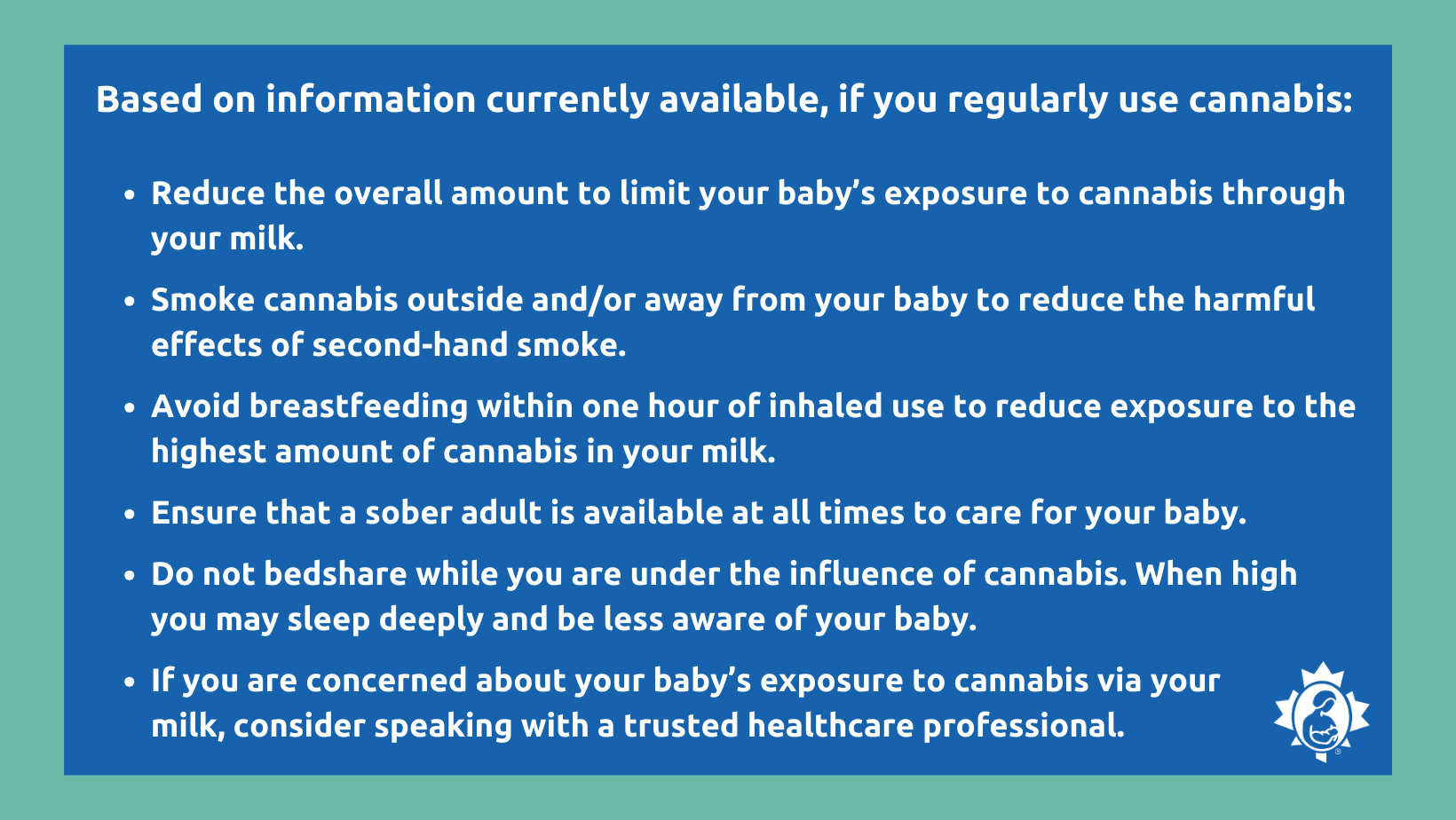
Some parents are concerned about the risks of using cannabis while breastfeeding. Some parents feel that cannabis positively affects their mental health, which enables them to breastfeed and meet their mothering goals. Weighing the risks and making a decision can be challenging. It is important to have reliable information.
In this information sheet we will share current available research so that you can make the best decision for you and your baby.
Health Canada states:
- Until more is known about the short and long-term effects of cannabis, it is safest to avoid using cannabis when parenting and breastfeeding.
- Breastfeeding is the healthiest choice for your baby.
Cannabis is legal for both recreational and medicinal use in Canada. It is known as weed, pot, marijuana and other names. It can be consumed by smoking, eating, and vaping. Hash is another product made from the cannabis plant.
Delta-9-tetrahydrocannabinol (THC) is the psychoactive substance in cannabis which makes users feel “high.”
Cannabidiol (CBD) is a different substance in cannabis. It does not have psychoactive effects and does not make a person feel “high”. It is often used to reduce pain, inflammation, anxiety and depression.
The effects of cannabis exposure are dose related. If you use cannabis occasionally, your baby is exposed to less of it. However, if you use it regularly, your baby is exposed to more cannabis. This means that the risks to an infant of occasional exposure to cannabis are different from regular and chronic exposure.
IS CANNABIS SAFE TO USE WHILE BREASTFEEDING?
This is a difficult question to answer for several reasons:
- Lack of available research
- Variable maternal THC absorption
- THC and CBD are fat soluble
- Variable factors like: baby’s age, baby’s health, and amount of exposure to cannabis
Lack of available research
Much of the available research on the impacts of cannabis use during breastfeeding is many years old and is now dated. Many of the current studies were conducted with small numbers of participants. Because most of this research was conducted when cannabis use was illegal in Canada, it may impact the results. It was also conducted when THC levels in cannabis were lower than they are today. In the 1960s and 1970s, THC levels were approximately 1%. They have increased steadily over the decades. Today THC levels in cannabis can be as high as 30%. In the decade between 2008 and 2017 the mean THC concentration increased dramatically from 8.9% in 2008 to 17.1% in 2017.4
In recent years, new research has come out providing more information on the impact of cannabis use during breastfeeding. At this time, the available research has produced conflicting results and therefore conflicting recommendations for cannabis use during breastfeeding.
Variable of maternal THC absorption
The amount of THC a mother’s body absorbs varies, depending on how she consumes cannabis and how often she uses it. More THC is absorbed when cannabis is smoked than when it is eaten. Occasional users of cannabis absorb approximately half as much THC as regular users (Hale, 2019). The amount of THC a mother’s body absorbs impacts the amount that the baby’s body absorbs. THC transfers into human milk in small amounts, approximately 2.5% of the adult dosage. But this number does not give the whole picture.
THC and CBD are fat soluble
THC is fat soluble and is stored in the fat and fatty organs, like breast tissue. It is released slowly, over time. This is different from alcohol, which is completely eliminated by a woman’s body within an hour or so after finishing a drink. THC, however, can remain in the mother’s body and milk for many days and even weeks after use. One study showed cannabis in the mother’s body six days after the last use. Another study found that THC can be detected in baby’s urine for up to 3 weeks after the mother’s last cannabis use. The levels of THC in the milk of heavy, regular cannabis users can build up to as high as eight times the levels in the mother’s blood serum.13 The levels of THC in the milk and blood of regular cannabis users can also be eight times higher than in that of occasional users.
CBD products may contain THC. Early research predicts that CBD passes into human milk in very small amounts. (This is less than the amounts prescribed to young children for a variety of health conditions, like epilepsy).18 However, further research is needed to determine the actual amounts of CBD in the milk of mothers who use cannabis. There is currently no research on the effects of CBD oils on the baby during pregnancy or breastfeeding. However, it is likely that CBD accumulates in fatty tissues like THC.
There is wide variability in the length of time THC and CBD remain in a mother’s fat stores, blood and milk. For regular cannabis users, THC and CBD can build up in the fat stores over time, increasing the amount of THC exposure to babies.
Variable of factors like: baby’s age, baby’s health, and amount of exposure to cannabis
The ability of a baby to tolerate exposure to THC depends on many factors. More research is needed to determine which factors influence the safety of cannabis consumption when breastfeeding. Researchers need to consider the infant’s age and health status. They also need to look at the amount of cannabis the infant is exposed to.
IMPACT OF CANNABIS ON NURSING BABIES
The immediate effects on a baby for any level of exposure, but particularly heavy exposure, can be sedation, weakness and poor feeding.1
The effects of exposure to cannabis through human milk on infant development are not yet well defined through high-quality studies. According to a 2020 systematic review, there have been only two observational studies to date.15 One study indicated there was no impact of cannabis use on long-term development. The other study found that motor development at the age of one year was slightly reduced in babies who were regularly exposed. Additionally, babies who are exposed to THC via human milk may have been exposed prenatally, making it difficult to determine what changes have occurred, and when.7
IMPACT OF CANNABIS ON MILK PRODUCTION
There is some evidence in animal and human studies that cannabis may suppress prolactin production. This could negatively affect milk production. Some studies have found that women who use cannabis have a lower breastfeeding duration than those who do not.6, 11 A more recent study found no difference in breastfeeding initiation or duration between cannabis users and non-cannabis users.5 Prolactin plays an important role in the establishment of milk production. Thus, a decrease in prolactin may have a greater effect on milk production in the early weeks of a baby’s life. If breastfeeding is well established, then prolactin suppression may not affect milk production.
ABILITY TO CARE FOR BABY WHILE USING CANNABIS
Using cannabis can impair a parent’s ability to care for an infant safely. It is important to always have a sober adult present to care for your baby if you have consumed cannabis. Cannabis should not be smoked around your baby. Inhaling smoke is harmful to babies.* (Lactmed)
Bedsharing should be avoided when parents are high from cannabis use. They can fall into a deep sleep with a risk of overlying and suffocating the baby.
Cannabis use has been linked to elevated SIDS risk for infants of mothers using it. There have been three studies to date. One study found a strong association between prenatal cannabis use and sudden unexplained infant death syndrome (SUIDS, also known as SIDS).2 One older study found a much smaller association16 and one found no association.10
RECOMMENDATIONS
With limited current research, it is difficult to determine the risks to the baby of cannabis exposure via mothers’ milk. Breastfeeding provides protective effects of human milk on baby’s health, development and immune function. If you are breastfeeding your baby and decide to use cannabis, consider the risks in consultation with your healthcare provider.
Factors to consider when deciding whether to use cannabis include:
- how often you use it,
- how you use it,
- the reliability of your milk supply,
- your baby’s health,
- the age of your baby.
Using formula to replace your milk is not recommended. It exposes your baby to the many known risks of substitutes for human milk.

References
- Astley, S.J., Little, R.E. (1990). “Maternal marijuana use during lactation and infant development at one year.” Neurotoxicology and teratology, Mar-Apr;12(2):161-8.
- Bandoli, G., Delker, E., Schumacher, B.T., Baer, R.T., Kelly, A.E., Chambers, E.D. (2023). “Prenatal cannabis use disorder and infant hospitalization and death in the first year of life.”Drug and Alcohol Dependence, vol 242.
- “Cannabis.” (November, 2023). Drugs and Lactation Database (Lactmed).
- Chandra, S., Radwan, M.M., Majumdar, C.G. et al. New trends in cannabis potency in USA and Europe during the last decade (2008–2017). (2019). European Archives of Psychiatry and Clinical Neuroscience, 269, 5–15.
- Coy, K. C., Haight, S. C., Anstey, E., Grant, A. M., Ruffo, N., & Ko, J. Y. (2021). Postpartum Marijuana Use, Perceptions of Safety, and Breastfeeding Initiation and Duration: An Analysis of PRAMS Data From Seven States, 2017. Journal of human lactation : official journal of International Lactation Consultant Association, 37(4), 803–812.
- Crume, T.L., Juhl, A.L., Brooks-Russell, A., Hall, K.E., Wymore, E., & Borgelt, L.M. (2018). Cannabis use during the perinatal period in a state with legalized recreational and medical marijuana: The association between maternal characteristics, breastfeeding patterns, and neonatal outcomes. The Journal of Pediatrics, 197, 90–96. doi: 10.1016/j.jpeds.2018.02.005
- Harris, M., Schiff, D.M., Saia, K., Muftu, S., Standish, K.R., Wachman, E.M. (2023). Academy of Breastfeeding Medicine Protocol #21: Breastfeeding in the Setting of Substance Use and Substance Use Disorder, vol 18, number 10.
- Health Canada. (2018). Cannabis resource series: Is cannabis safe during preconception, pregnancy and breastfeeding?
- Health Canada. (2018). Thinking about using cannabis while parenting?
- Klonoff-Cohen,H., Lam-Kruglick, P. (2001). “Maternal and paternal recreational drug use and sudden infant death syndrome.” Archives of Pediatrics and Adolescent Medicine, 155, p.765.
- Ko, J.Y., Tong, V.T., Bombard, J.M., Hayes, D.K., Davy, J., & Perham-Hester, K.A. (2018). Marijuana use during and after pregnancy and association of prenatal use on birth outcomes: A population-based study. Drug and Alcohol Dependence, 187, 72–78.
- La Leche League Great Britain. (2016). Smoking, Vaping, Cannabis and Breastfeeding.
- Mohrbacher, Nancy. (2020). Breastfeeding Answers: A Guide for Helping Families, Second Edition. Nancy Mohrbacher Solutions, Inc.
- Ordean, A. (2014). Marijuana exposure during lactation: Is it safe? International Journal of Pediatric Research,
- Ordean, A., & Kim, G. (2020). Cannabis Use During Lactation: Literature Review and Clinical Recommendations. Journal of obstetrics and gynaecology Canada : JOGC, 42(10), 1248–1253.
- Scragg, R.K., Mitchell, E.A., Ford, R.P., Thompson, J.M., Taylor, B.J., Stewart, A.W. (2001). “Maternal cannabis use in the sudden death syndrome.” Acta Paediatrica, 90, pp. 57-60.
- Wading Through The Weeds: A Public Health Response to Supporting Pregnant and Breast Chestfeeding People who Consume Cannabis. (2022). Native Women’s Association of Canada, Canadian Centre on Substance Abuse and Addiction and McMaster University.
- Yeung, C.H.T., Bertrand, K.A., Best, B.M., Capparelli, E., Chambers, C.D., Hajducek, D.M., Hamadeh, A., Ito, S., Momper, J.D., Edginton, A.N. (2023). “Cannabidiol Exposure Through Maternal Marijuana Use: Predictions in Breastfed Infants.” Clinical Pharmacokinetics; 62(11): 1611-1619.
